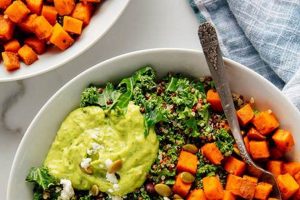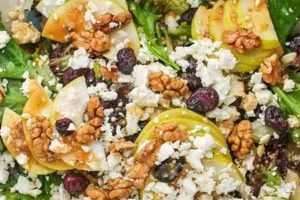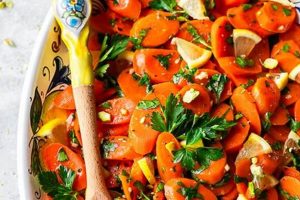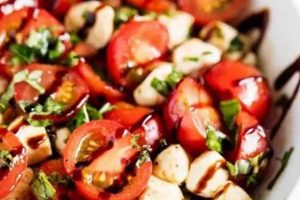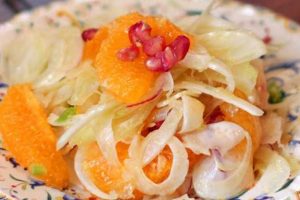This dish typically combines shredded cabbage, often Napa or savoy, with cooked ramen noodles (discarding the flavor packet). A vibrant dressing, frequently based on sesame oil, soy sauce, rice vinegar, and ginger, binds the ingredients. Additions like shredded carrots, sliced almonds, chopped scallions, or edamame enhance the textural and flavor complexity. Variations can include different vegetables, proteins like shredded chicken or tofu, and alternative dressings.
A crunchy, refreshing, and budget-friendly meal, this salad offers nutritional value from the cabbage and optional added vegetables. Its adaptability to various ingredients and flavor profiles contributes to its popularity. The dish’s origins likely stem from Asian cuisine, reflecting the versatility of ramen and the refreshing qualities of a cold noodle salad. Its easy preparation and customizable nature make it suitable for quick lunches, potlucks, or light dinners.
Further exploration will cover specific recipes, variations, nutritional information, and tips for achieving optimal flavor and texture. Different cabbage types, dressing options, and suggested protein additions will be discussed to provide a comprehensive understanding of this versatile and appealing dish.
Tips for a Superior Cabbage and Ramen Noodle Salad
Optimizing ingredient preparation and combining flavors are crucial for a successful salad. The following tips ensure a satisfying and flavorful experience.
Tip 1: Noodle Preparation: Cook ramen noodles according to package directions, but slightly undercook for optimal texture. Rinse with cold water to stop the cooking process and enhance firmness. This prevents a mushy texture in the final salad.
Tip 2: Cabbage Selection and Preparation: Napa or savoy cabbage are recommended for their delicate texture and flavor. Finely shred the cabbage for easier eating and even distribution of the dressing.
Tip 3: Dressing Emulsification: Whisk the dressing ingredients vigorously to create an emulsion that evenly coats the salad components. A stable emulsion enhances flavor distribution and prevents a watery consistency.
Tip 4: Ingredient Balance: Balance the flavors and textures by incorporating a variety of vegetables, such as shredded carrots, julienned bell peppers, or chopped cilantro. This adds nutritional value and visual appeal.
Tip 5: Protein Enhancement (Optional): Consider adding a protein source like shredded cooked chicken, crumbled tofu, or edamame for a more substantial meal. This complements the vegetables and noodles for a balanced nutritional profile.
Tip 6: Flavor Adjustment: Taste and adjust the dressing as needed. Additional soy sauce, rice vinegar, or a touch of sweetness can be added to achieve the desired flavor balance.
Tip 7: Chilling Time (Optional): Chilling the salad for a short period allows the flavors to meld and the ingredients to further absorb the dressing. This step enhances the overall taste experience.
By following these tips, one can elevate a simple cabbage and ramen noodle salad to a flavorful and texturally satisfying culinary creation.
The following section offers several variations on this adaptable recipe, allowing for customization to individual preferences and dietary needs.
1. Fresh, Crisp Cabbage
Fresh, crisp cabbage provides the foundation for a successful cabbage noodle salad with ramen noodles. Its textural integrity contrasts with the soft noodles, contributing a satisfying crunch. Cabbage selection and preparation significantly impact the final dish’s quality. Wilted or limp cabbage results in a less appealing, potentially soggy salad. Conversely, crisp cabbage maintains its structure, offering a refreshing counterpoint to the other ingredients. For example, using crisp Napa cabbage creates a light and delicate salad, while sturdier savoy cabbage adds a robust texture.
The choice of cabbage also influences flavor. Napa cabbage offers a subtly sweet and mild flavor, while savoy cabbage presents a slightly peppery and more pronounced taste. These nuances affect how the cabbage interacts with the dressing and other ingredients. Furthermore, proper storage techniques are essential. Refrigerating cabbage in a sealed container or wrapped tightly in plastic wrap maintains its crispness and prevents dehydration. Slicing or shredding the cabbage just before assembling the salad further preserves its fresh texture.
Achieving textural and flavor balance hinges on the quality of the cabbage. Fresh, crisp cabbage ensures the salad remains appealing, avoiding an undesirable mushy consistency. This understanding allows for informed ingredient selection and proper handling, ultimately contributing to a more satisfying culinary experience. The crispness of the cabbage not only enhances the textural appeal but also contributes to the overall refreshing quality of the salad, making it a particularly enjoyable dish in warmer weather.
2. Cooked Ramen Noodles
Cooked ramen noodles constitute a fundamental component of the cabbage noodle salad, contributing texture, flavor absorption, and overall structure. Their preparation and handling significantly influence the final dish’s quality.
- Cooking Method and Texture:
Proper cooking ensures the noodles reach the desired textureneither too firm nor overly soft. Slightly undercooking, followed by rinsing under cold water, yields a firmer noodle that holds its shape better in the salad, preventing a mushy consistency. Overcooked noodles tend to clump and absorb less dressing, resulting in an unevenly flavored salad.
- Flavor Absorption:
While the flavor packet included with ramen noodles is typically discarded for this salad, the noodles themselves possess a mild, neutral flavor that readily absorbs the dressing’s flavors. This absorption is crucial for distributing flavor throughout the salad. The porous nature of cooked ramen noodles allows them to effectively bind with the dressing, ensuring each bite is flavorful.
- Structural Integrity:
Cooked ramen noodles provide a textural contrast to the crisp cabbage and other vegetables. Their pliable yet resilient structure adds a satisfying mouthfeel to the salad. Properly cooked noodles contribute to the overall balance of textures, offering a pleasant chewiness that complements the crunch of the cabbage.
- Versatility and Adaptability:
Ramen noodles are readily available and adaptable to various flavor profiles. Their neutral taste serves as a blank canvas for the diverse range of dressings and ingredients commonly used in this salad. This adaptability contributes to the dish’s versatility and widespread appeal.
The interplay of these facetstexture, flavor absorption, structural integrity, and versatilityestablishes cooked ramen noodles as an essential element of the cabbage noodle salad. Careful attention to their preparation enhances the final dish, contributing to a balanced and flavorful culinary experience.
3. Flavorful Dressing
Flavorful dressing is paramount in a successful cabbage noodle salad with ramen noodles. It serves as the unifying element, binding the ingredients and imparting a cohesive flavor profile. The dressing’s characteristics significantly impact the overall culinary experience, influencing the balance of sweet, savory, tangy, and spicy notes.
- Balancing Flavor Profiles:
A well-crafted dressing balances contrasting flavors, creating a harmonious blend that complements the other ingredients. The interplay of sweet, sour, salty, and umami elements is essential. For instance, a dressing featuring rice vinegar (sour), soy sauce (salty), sesame oil (umami), and a touch of sugar (sweet) achieves a balanced profile. This balance prevents any single flavor from overpowering the others, allowing the nuances of each ingredient to shine through.
- Enhancing Ingredient Compatibility:
The dressing enhances the compatibility of diverse ingredients, creating a cohesive flavor experience. It bridges the flavors of the cabbage, noodles, and any additional components, such as proteins or vegetables. A sesame-ginger dressing, for example, complements both the subtle sweetness of Napa cabbage and the nutty flavor of sesame seeds, while also providing a savory element that enhances the overall taste.
- Textural Considerations:
The dressing’s viscosity contributes to the overall textural experience. A thicker dressing clings to the ingredients more effectively, ensuring even flavor distribution. A thinner dressing, while offering a lighter touch, may require more frequent tossing to maintain consistent flavor. The choice of dressing consistency depends on the desired textural outcome and personal preference. A creamy peanut dressing, for example, offers a different textural experience compared to a light vinaigrette.
- Customization and Adaptability:
The dressing allows for customization and adaptability, catering to individual preferences and dietary restrictions. Variations in ingredients and proportions can create unique flavor profiles. For example, a spicy dressing can be achieved by incorporating chili flakes or sriracha, while a vegan option can be created by substituting traditional soy sauce with tamari. This adaptability makes the salad versatile and suitable for a wide range of palates.
The flavorful dressing acts as the cornerstone of the cabbage noodle salad, elevating it from a simple combination of ingredients to a cohesive and satisfying culinary creation. Its careful consideration and balanced execution are essential for achieving a harmonious and enjoyable dining experience. The interplay of flavors, textures, and adaptability highlights the crucial role of the dressing in transforming this simple salad into a culinary masterpiece.
4. Optional protein additions
Optional protein additions represent a significant opportunity to enhance the nutritional value and overall culinary experience of a cabbage noodle salad with ramen noodles. While the base recipe offers a satisfying blend of flavors and textures, incorporating protein transforms the dish into a more complete and substantial meal. This exploration examines the multifaceted role of protein additions in elevating the salad’s nutritional profile, flavor complexity, and textural diversity.
- Nutritional Enhancement:
Protein additions contribute essential amino acids, crucial for muscle building, tissue repair, and overall bodily functions. Incorporating protein transforms the salad from a light accompaniment to a more balanced meal, particularly beneficial for individuals seeking increased protein intake. Grilled chicken, tofu, or edamame, for example, significantly boost the protein content, enhancing the salad’s nutritional value.
- Flavor Complexity:
Protein sources introduce diverse flavor profiles that complement and enhance the existing flavors of the salad. The savory notes of grilled chicken or the subtle nuttiness of tofu interact with the dressing and vegetables, creating a more layered and complex taste experience. The choice of protein influences the overall flavor direction, allowing for customization and exploration of diverse taste combinations.
- Textural Variety:
Protein additions introduce varying textures that contribute to a more dynamic and satisfying mouthfeel. The tender texture of cooked chicken contrasts with the crisp cabbage and chewy noodles, while the firm texture of tofu or the pop of edamame adds another dimension to the sensory experience. This interplay of textures elevates the salad beyond a simple combination of ingredients, creating a more engaging culinary experience.
- Versatility and Adaptability:
The choice of protein allows for versatility and adaptability to individual dietary preferences and culinary goals. From lean poultry to plant-based options like tofu or tempeh, the possibilities are extensive. This adaptability ensures the salad remains a flexible and customizable dish, catering to diverse tastes and nutritional needs. The incorporation of different proteins also allows for exploration of various culinary traditions, reflecting the versatility of the dish.
By strategically incorporating protein additions, the cabbage noodle salad with ramen noodles transcends its role as a simple side dish and becomes a more complete and satisfying meal. The interplay of enhanced nutritional value, flavor complexity, and textural variety demonstrates the significant contribution of protein in elevating this versatile dish to new culinary heights.
5. Crunchy Toppings
Crunchy toppings represent a crucial element in elevating the textural complexity and overall sensory experience of a cabbage noodle salad with ramen noodles. While the base recipe offers a pleasant contrast between the crisp cabbage and tender noodles, the strategic incorporation of crunchy toppings introduces another dimension, enhancing the dish’s appeal and providing a satisfying counterpoint to the softer elements.
- Textural Contrast:
Crunchy toppings provide a stark textural contrast to the softer components of the salad, such as the cooked noodles and cabbage. This interplay of textures creates a more dynamic and engaging mouthfeel. The juxtaposition of crispness against softness enhances the overall sensory experience, making each bite more interesting and enjoyable. For example, toasted sesame seeds offer a delicate crunch, while chopped peanuts provide a more robust and substantial bite.
- Flavor Enhancement:
Beyond textural contributions, crunchy toppings often introduce complementary flavors that enhance the overall flavor profile of the salad. Toasted nuts, for example, offer a rich, nutty flavor that complements the savory notes of the dressing. Fried onions contribute a subtle sweetness and umami depth, while crispy wonton strips provide a savory and slightly salty accent. The choice of crunchy topping can significantly influence the overall taste experience.
- Visual Appeal:
Crunchy toppings contribute to the visual appeal of the salad, adding color and textural variation to the surface. A sprinkle of sesame seeds, chopped peanuts, or fried onions creates visual interest and elevates the presentation. This visual enhancement makes the salad more appetizing and contributes to a more enjoyable dining experience.
- Versatility and Customization:
The wide array of available crunchy toppings allows for extensive customization and adaptability to individual preferences. From the delicate crunch of sesame seeds to the bolder texture of chopped cashews, the options are diverse. This versatility allows individuals to tailor the salad to their specific tastes and preferences, creating a personalized culinary experience. The choice of crunchy topping can also reflect specific dietary needs and preferences, such as opting for gluten-free options or avoiding specific allergens.
The inclusion of crunchy toppings in a cabbage noodle salad with ramen noodles significantly elevates the dish from a simple combination of ingredients to a multi-textured and flavorful culinary creation. The interplay of textures, complementary flavors, visual appeal, and versatility demonstrates the crucial role crunchy toppings play in enhancing the overall dining experience. The strategic selection and application of these toppings transform the salad into a more complex and satisfying culinary endeavor.
6. Balanced Textures
Balanced textures are essential for a successful cabbage noodle salad with ramen noodles. This characteristic significantly impacts the overall enjoyment of the dish, elevating it beyond a simple combination of ingredients. Achieving textural harmony requires a careful consideration of the various components and their interplay within the salad.
- Contrast and Complement:
Textural balance relies on the interplay of contrasting and complementary textures. The crispness of raw cabbage provides a refreshing counterpoint to the soft, chewy texture of the cooked ramen noodles. This contrast prevents the salad from becoming monotonous, creating a dynamic and engaging mouthfeel. The addition of other ingredients, such as crunchy toppings or protein elements, further enhances this textural complexity.
- Ingredient Selection and Preparation:
Achieving textural balance starts with ingredient selection and preparation. Using fresh, crisp cabbage is crucial, as wilted cabbage compromises the intended textural contrast. Properly cooking the ramen noodlesavoiding overcookingensures they retain a pleasant chewiness. Similarly, the choice of additional ingredients, such as crisp bean sprouts or firm tofu, contributes to the overall textural profile.
- Impact on Sensory Experience:
The balanced textures of the salad contribute significantly to the sensory experience of consuming the dish. The interplay of crispness, chewiness, and potentially other textural elements, such as creaminess from a dressing or crunch from toppings, creates a more satisfying and enjoyable mouthfeel. This heightened sensory experience elevates the dish beyond mere sustenance, transforming it into a more engaging culinary experience.
- Customization and Personalization:
The concept of balanced textures allows for customization and personalization of the salad. Individuals can adjust the proportions of ingredients or incorporate additional elements to achieve their desired textural profile. For example, adding more crunchy toppings enhances the crispness, while incorporating creamy avocado introduces a contrasting smoothness. This adaptability makes the salad a versatile dish that can cater to individual preferences.
The balanced textures in a cabbage noodle salad with ramen noodles contribute significantly to its appeal and overall enjoyment. The careful consideration of textural contrast and complement, ingredient selection, and the impact on sensory experience elevates this simple dish to a more complex and satisfying culinary creation. This understanding empowers individuals to customize the salad to achieve their preferred textural balance, ensuring a more personalized and enjoyable dining experience.
7. Versatile Recipe
The concept of “versatile recipe” finds a strong embodiment in the cabbage noodle salad with ramen noodles. This adaptability stems from the inherent flexibility of the core ingredients and their receptiveness to a wide range of additions and modifications. The neutral flavor profile of cabbage and ramen noodles provides a blank canvas for culinary exploration, allowing for customization based on individual preferences, dietary restrictions, and available ingredients. This inherent versatility distinguishes the dish, contributing to its widespread appeal and suitability for diverse culinary contexts.
The practical significance of this versatility manifests in several ways. The ability to substitute ingredients allows for adaptation to seasonal availability and dietary needs. For example, swapping cabbage varieties, incorporating different proteins (tofu, chicken, shrimp), or adding various vegetables (carrots, bell peppers, edamame) alters the nutritional profile and flavor profile without compromising the fundamental structure of the dish. Similarly, the dressing can be modified to reflect regional flavor preferences or accommodate dietary restrictions, using ingredients like low-sodium soy sauce, alternative sweeteners, or different types of vinegar. This adaptability makes the cabbage noodle salad a practical and economical meal option, minimizing food waste and maximizing culinary creativity.
This versatility extends beyond individual adaptations. The salad’s adaptability translates well to different serving scenarios. It functions effectively as a light lunch, a side dish at a larger meal, or a component of a potluck gathering. Its make-ahead nature and ability to hold up well over time further enhance its practicality. Furthermore, the salad’s adaptability extends to flavor profiles, ranging from spicy and savory to sweet and tangy, accommodating a wide range of palates. This versatility distinguishes the cabbage noodle salad with ramen noodles as a highly adaptable and broadly appealing culinary creation, suitable for diverse contexts and individual preferences.
Frequently Asked Questions
This section addresses common inquiries regarding the preparation and variations of cabbage noodle salad with ramen noodles.
Question 1: Can alternative noodles be used if ramen noodles are unavailable?
While ramen noodles offer a unique texture and flavor profile, other noodles, such as spaghetti, soba, or even rice noodles, can be substituted. However, adjusting cooking times may be necessary to achieve the desired texture.
Question 2: How can the salad be made more nutritious?
Nutritional value can be increased by incorporating additional vegetables like shredded carrots, bell peppers, or edamame. Adding a protein source, such as grilled chicken, tofu, or shrimp, further enhances the nutritional content.
Question 3: What are suitable dressing alternatives for those with soy allergies?
Tamari or coconut aminos offer suitable alternatives to soy sauce in dressings. Recipes can also be adapted to feature dressings based on alternative flavor profiles, such as sesame-ginger or peanut-lime.
Question 4: How long can the salad be stored in the refrigerator?
Properly stored in an airtight container, the salad typically lasts for 2-3 days in the refrigerator. However, the addition of certain ingredients, such as avocado, may shorten the storage lifespan.
Question 5: Can the salad be prepared in advance for a potluck or gathering?
The salad components, excluding the dressing, can be prepared in advance and stored separately. The dressing should be added just before serving to prevent the salad from becoming soggy. This approach maintains optimal texture and flavor.
Question 6: How can the flavor profile be adjusted to individual preferences?
Flavor customization can be achieved through adjustments to the dressing. Adding ingredients such as sriracha for spice, honey or maple syrup for sweetness, or different types of vinegar for tanginess allows for personalized flavor profiles.
Understanding these common inquiries facilitates successful preparation and adaptation of this versatile dish to individual needs and preferences.
The following section offers concluding thoughts and recipe variations for further exploration.
Cabbage Noodle Salad Recipe with Ramen Noodles
Exploration of this dish reveals its adaptable nature. Key elements include fresh, crisp cabbage; properly cooked ramen noodles; a balanced, flavorful dressing; optional protein additions for enhanced nutrition; crunchy toppings for textural complexity; and an overall balance of textures. The versatility of this recipe allows for customization based on individual preferences and dietary needs. From ingredient selection to dressing variations, the dish offers a platform for culinary creativity.
The simplicity of preparation combined with the potential for diverse flavor profiles positions this dish as a practical and enjoyable meal option. Continued exploration of variations and flavor combinations offers a path to further culinary discovery. Understanding the foundational elements empowers individuals to create personalized versions, highlighting the enduring appeal of this adaptable and satisfying salad.


